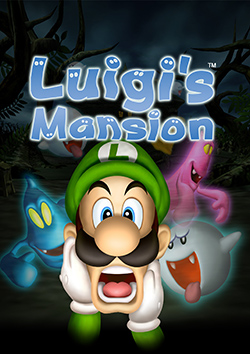
Luigi's Mansion is a 2001 action-adventure game developed and published by Nintendo. The game was a launch title for the GameCube and was the first game in the Mario franchise to be released for the console; it was released in Japan on September 14, 2001, in North America on November 18, 2001, in Europe on May 3, 2002, and in Australia on May 17, 2002. It is the third video game in which Luigi is the main character instead of Mario, after Mario Is Missing! and Luigi's Hammer Toss. Players control him as he explores a haunted mansion, searches for Mario and deals with ghosts by capturing them through a vacuum cleaner supplied by Professor E. Gadd.
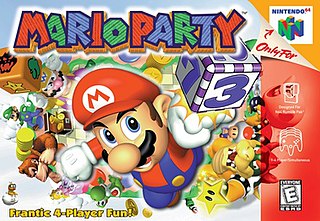
Mario Party is a 1998 party video game developed by Hudson Soft and published by Nintendo for the Nintendo 64. The game was targeted at a young audience. Mario creator Shigeru Miyamoto served as development supervisor. It received mostly positive critical reviews for its multiplayer mode, concept, and music; disapproval of its slow pacing; and mixed reviews of its graphics. It is the first installment in the Mario Party series and was followed by Mario Party 2 in 1999. The game received its first official re-release on the Nintendo Switch Online + Expansion Pack in 2022.

Mario Party 4 is a 2002 party video game developed by Hudson Soft and published by Nintendo for the GameCube. The game is the fourth installment in the Mario Party series and is the first game in the series to be released for the GameCube. Like the previous games in the series, it features eight playable characters: Mario, Luigi, Princess Peach, Yoshi, Wario, Donkey Kong, Princess Daisy, and Waluigi from the Mario franchise, who can be directed as characters on 6 themed game boards. The objective is to earn as many stars as possible, which are obtained by purchase from a single predefined space on the game board. Each character's movement is determined by a roll of a die, with a roll from each player forming a single turn. Each turn is followed by a minigame in which characters compete for coins they can use to purchase items and stars.

Mario Party 2 is a 1999 party video game developed by Hudson Soft and published by Nintendo for the Nintendo 64. The second game in the Mario Party series, it was released in Japan in December 1999 and worldwide in 2000. The game received mostly positive reviews, who praised the improvements they made to the original, the multiplayer and minigames, but criticized the lack of originality, while graphics received a better but otherwise mixed response.

Mario Party 5 is a party video game developed by Hudson Soft and published by Nintendo for the GameCube. It is the fifth installment in the Mario Party series and the second game in the series to be released for the GameCube. It was first released in North America and Japan in November 2003, followed by Europe a month later. The game is set in the fictional Dream Depot, consisting of seven game boards. The single-player "Story" mode involves the player winning multiple games against the Koopa Kids to prevent Bowser from conquering the Dream Depot. The main multiplayer game mode consists of four characters from the Mario series playing a board game, with each board having a set theme. The game also features several minigames, which are played after every set of turns. Mario Party 5 introduces the "Super Duel" mode to the franchise, which requires players to assemble and control custom made battle vehicles which can be used in combat against other machines. The game features ten playable characters, with playable debuts to the series from Toad, Boo, and Koopa Kid.

Mario Party is a party video game series featuring characters from the Mario franchise in which up to four local players or computer-controlled characters compete in a board game interspersed with minigames. The games are currently developed by NDcube and published by Nintendo, being previously developed by Hudson Soft. The series is known for its party game elements, including the often unpredictable multiplayer modes that allow play with up to four, and sometimes eight, human players or CPUs.

Mario Party 6 is the sixth installment in the Mario Party series of board game-style party video games by Nintendo and is the third game in the series made for the GameCube and was released in Japan on November 18, 2004; in North America on December 6, 2004; in Europe on March 18, 2005; and in Australia on September 15, 2005. It is the first GameCube game to make use of a microphone add-on.

Mario Party 8 is a 2007 party video game developed by Hudson Soft and published by Nintendo for the Wii. It is the eighth main installment in the Mario Party series, as well as the first title in the series to be released for the Wii.

Super Mario is a platform game series created by Nintendo starring their mascot, Mario. It is the central series of the greater Mario franchise. At least one Super Mario game has been released for every major Nintendo video game console. However, there have also been a number of Super Mario video games released on non-Nintendo gaming platforms. There are more than 20 games in the series.
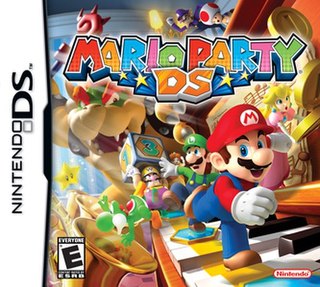
Mario Party DS is a 2007 party video game developed by Hudson Soft and published by Nintendo for the Nintendo DS. It is the second handheld game in the Mario Party series, as well as the last game in the series to be developed by Hudson Soft, as all subsequent titles have been developed by NDcube. The game was later released on the Virtual Console for the Wii U in April 2016.
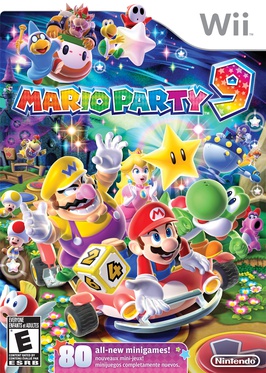
Mario Party 9 is a 2012 party video game developed by NDcube and published by Nintendo for the Wii. The ninth main installment in the Mario Party series, it was announced at E3 2011 and released in Europe, North America, and Australia in March 2012, followed by Japan a month later. It was the first game in the series not to be developed by Hudson Soft, which was acquired and dissolved by Konami on March 1, 2012, the day before the game's European release. Instead, development was taken over by Nintendo studio NDCube. This was also the final Mario game to be released on the Wii.
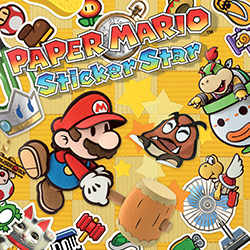
Paper Mario: Sticker Star is a 2012 role-playing game developed by Intelligent Systems and published by Nintendo for the Nintendo 3DS. It is the fourth installment in the Paper Mario series and part of the larger Mario franchise; it is the first game in the series released on a handheld console. In the game, the protagonist Mario and a new ally named Kersti travel across the Mushroom Kingdom to retrieve the six Royal Stickers scattered by Bowser. The game was released in November 2012 in North America and December 2012 overseas.

Nintendo Land is a party video game developed and published by Nintendo as a pack-in launch title for the Wii U home video game console in 2012. The game was first announced at E3 2012 during Nintendo's press conference.

Mario and Donkey Kong: Minis on the Move, known in Japan as Mario & Donkey Kong: MiniMini Carnival, is a 2013 puzzle game developed by Nintendo Software Technology for the Nintendo 3DS. The fifth entry in the Mario vs. Donkey Kong series, it was released exclusively via the Nintendo eShop download service on May 9, 2013, in the PAL region and North America, and on July 24 in Japan.
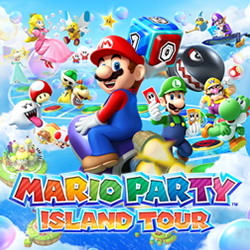
Mario Party: Island Tour is a party video game developed by NDcube and published by Nintendo for the Nintendo 3DS. The third handheld game in the Mario Party series, it was announced by Satoru Iwata in a Nintendo Direct presentation in April 2013, and was released in November 2013 in North America, in January 2014 in Europe and Australia, and in March 2014 in Japan. The game features seven boards, each with their own special features, and 81 new minigames. It was followed by Mario Party 10 for the Wii U in 2015.
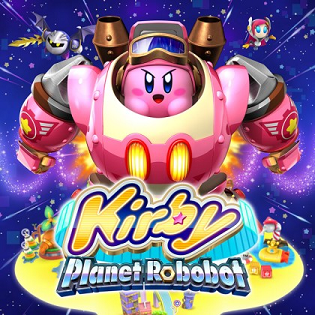
Kirby: Planet Robobot is a 2016 platform game developed by HAL Laboratory and published by Nintendo for the Nintendo 3DS. It is the eleventh mainline installment in the Kirby series and the spiritual sequel to Triple Deluxe. The story follows Kirby as he defends Planet Popstar from an alien corporation known as the Haltmann Works Company that wishes to mechanize the planet so that they can plunder its natural resources. New to the series in this game is Kirby's ability to utilize a mecha suit known as the Robobot Armor to solve puzzles and fight enemies.

Mario Sports Superstars is a 2017 sports video game developed by Bandai Namco Studios and Camelot Software Planning and published by Nintendo for the Nintendo 3DS. The game contains five sports minigames: football, baseball, tennis, golf, and horse racing, and was released in March 2017.

Mario Party: The Top 100 is a party video game developed by NDcube and published by Nintendo for the Nintendo 3DS. It is the fifth installment in the handheld series of Mario Party games and is primarily a compilation of 100 minigames from across the series. It was released first in North America in November 2017, and was released in PAL regions and in Japan in December 2017. It is the third and final Mario Party game for the Nintendo 3DS family of systems. A similar entry on the Nintendo Switch, Mario Party Superstars, was released in 2021.

Super Mario Party is a party video game developed by NDcube and published by Nintendo for the Nintendo Switch. The eleventh main entry in the Mario Party series, the game was described as a "complete refresh" of the franchise, bringing back and revitalizing gameplay elements from older titles while also introducing new ones to go along with them. It was released worldwide on 5 October 2018 and sold 1.5 million copies by the end of the month. As of December 31, 2023, the game has sold more than 20.34 million copies worldwide, making it one of the top ten best-selling games on the system. Mario Party Superstars, a game featuring maps remastered from earlier entries and a return to the original formula, was released in 2021.

Mario Party Superstars is a 2021 party video game developed by NDcube and published by Nintendo for the Nintendo Switch. It is the twelfth home console installment in the Mario Party series, and the second for the Nintendo Switch following Super Mario Party (2018). It was released on October 29, 2021.




















